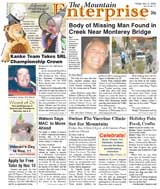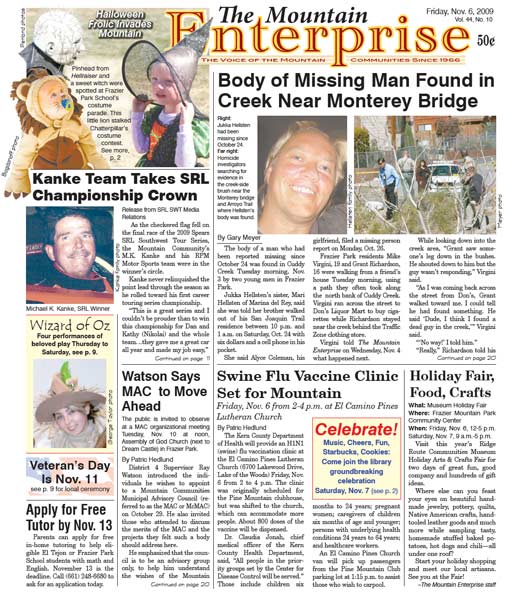By Katy Penland and Patric Hedlund
FRAZIER PARK, CA Wednesday, Nov. 4, 2009 — In a presentation at the regular meeting of the El Tejon Unified School District Board of Trustees tonight, Derrill Whitten of Cornerstone Engineering of Bakersfield revealed what he called a "significantly reduced plan" for building Frazier Park Estates near Frazier Mountain High School.
Whitten said the revised project calls for 550 homes to be built—compared to the originally proposed 662. The former plan also called for extensive "cut and fill" excavation and building along ridge lines. Now, Whitten says, there will be no construction on 60-degree slopes, which was in violation of the Kern County Hillside Development Ordinance.
Because the issue of water has been of greatest concern to the Kern County Planning Department, the high school and the surrounding water districts, the developer, Frank Arciero, Jr. has proposed an "incremental approach" to construction in order to monitor the effects each phase of development will have on water resources before proceeding to the next phase.
"The primary problem with this whole basin [referring to the water supply provided by the Cuddy Valley aquifer ] is that it’s been studied by at least three different hydrogeologists who have come up with pretty wide-ranging estimates of what’s available in the basin," Whitten said. "Those differences are because there’s just not enough data to know what’s going on in the basin."
By taking an "incremental approach" to an estimated 7-year build-out, the developer’s engineer said construction would begin with 200 homes, giving them the opportunity to study ground water consumption rates. He said this would provide hard data that would either support or refute their consumption models. If there are no adverse impacts to water resources, another 150 homes would be built within two years and monitoring would continue. "If at any point we find there’s not enough water, the project stops," Whitten said.
The developer’s representative also said that under the reduced plan, there would no longer be the vast amount of earthmoving required, and there would be no blasting at all. The "Badlands" area above the high school would not be utilized.
One area of concern expressed by board member Anita Anderson was the current location of the high school’s water pipes, which carry water over a mile to the school from the well near Frazier Mountain Park Road.
"Would your homes be built over our pipes?" Anderson asked. Whitten said that while he did not know exactly where the pipes were located, "someone will know" and the pipes will be accessible for repair if necessary.
Cornerstone Engineering will present their revised project to the Kern County Board of Supervisors on Tuesday, Dec. 8 in the Supervisors chambers, 1115 Truxtun Ave., Bakersfield.
It is expected that the developer will ask the supervisors to vote for an option in the law which is called an "economic override," to allow the developer to proceed with his plans despite the fact that the draft environmental impact report (DEIR) required by California’s Environmental Quality Act (CEQA) showed the development will have significant impacts.
Members of the TriCounty Watchdogs—a Mountain Communities organization that monitors development proposals—attended the presentation Wednesday night. Jan de Leeuw of Cuddy Valley wrote in his blog that the proposal by Whitten to build in "phases" is a classic case of "piecemealing" which is forbidden by CEQA.
In his commentary, de Leeuw wrote: "It is well established CEQA prohibits piecemeal environmental review by ‘chopping a large project into many little ones–each with a minimal potential impact on the environment–which cumulatively may have disastrous consequences.’ (Citizens Assn. for Sensible Development of Bishop Area v. County of Inyo (1985) 172 Cal. App. 3d 151, 165 [217 Cal. Rptr. 893].) Of course you can call it ‘phasing,’ but it still means that the second phase will be harder to analyze critically than the first one, and that the overall plan with 550 units is approved (as far as zoning and maps are concerned). And second, it also seems to me that this plan violates SB 221/610, which requires a project with over 500 houses to prove a 20 year water supply even in multiple drought years."
He also commented upon the developer’s plans for a commercial center adjacent to the Flying J in Lebec. This feature has received some positive comments from mountain residents who would like more shopping conveniences closer to home, from some real estate agents such as Stacey Havener and from County Supervisor Ray Watson, who said at a recent meeting that he feels commercial developments are essential for the economic development of this region.
In his blog (Not in My Backyard), de Leeuw said: "The phasing, by the way, have as a consequence that the commercial center will not yet be developed, because having only 200 homes is not sufficient for stores to come in. So the commercial center will have to wait until at least 2014, but if there is not enough water for the second phase it will never be built."
The Kern County Planning Department’s recommendation to the Board of Supervisors is for the developer to settle for 188 homes— total—along with the full commercial center development. They do not propose the notion of a "phased" project that would eventually total over 500 homes surrounding the high school.
In an interview with The Mountain Enterprise on October 8, Frank Arciero, Jr., who is the owner of the land and the principal developer, said that he had made an analysis and does not believe that the 188-home and commercial center option would yield enough profit to make his development efforts worthwhile.
Meanwhile, TriCoutny Watchdog member Eric Anderson told the Planning Commission on October 8 that the "economic development model of greatest interest to the mountain communities is that of ecotourism."
The ecotourism model was articulated by Mountain Community participants at the Synergy Summits in 2006 and 2007. The events were hosted by the Mountain Communities Chamber of Commerce and The Mountain Enterprise.
At those events, the notion was articulated of developing marketing plans to invite people from the densely-populated urban environments surrounding this region to visit the mountain’s special events, festivals, workshops, institutes, hunting, hiking, biking, off-roading, wilderness training and related cultural and recreational activities.
That economic model relies upon maintaining the natural appearance of the mountainscapes at the "gateway to the Mountain Communities" rather than creating tracts of housing developments that "look like just more of Castaic," Eric Anderson said.
This is part of the November 06, 2009 online edition of The Mountain Enterprise.
Have an opinion on this matter? We'd like to hear from you.


